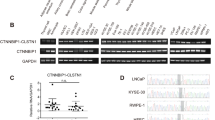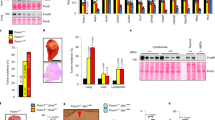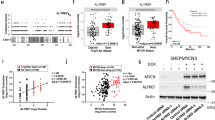Abstract
The amplified region of chromosome 19q13.1–13.2 has been associated with several cancers. The well-characterized oncogene AKT2 is located in this amplicon. Two members of the same gene family (SERTAD1 and SERTAD3) are also located within this region. We report herein the genomic structure and potential functions of SERTAD3. SERTAD3 has two transcript variants with short mRNA half-lives, and one of the variants is tightly regulated throughout G1 and S phases of the cell cycle. Overexpression of SERTAD3 induces cell transformation in vitro and tumor formation in mice, whereas inhibition of SERTAD3 by small interfering RNA (siRNA) results in a reduction in cell growth rate. Furthermore, luciferase assays based on E2F-1 binding indicate that SERTAD3 increases the activity of E2F, which is reduced by inhibition of SERTAD3 by siRNA. Together, our data support that SERTAD3 contributes to oncogenesis, at least in part, via an E2F-dependent mechanism.
This is a preview of subscription content, access via your institution
Access options
Subscribe to this journal
Receive 50 print issues and online access
$259.00 per year
only $5.18 per issue
Buy this article
- Purchase on Springer Link
- Instant access to full article PDF
Prices may be subject to local taxes which are calculated during checkout






Similar content being viewed by others
References
Abdullah JM, Jing X, Spassov DS, Nachtman RG, Jurecic R . (2001). Cloning and characterization of Hepp, a novel gene expressed preferentially in hematopoietic progenitors and mature blood cells. Blood Cells Mol Dis 27: 667–676.
Alarcon-Vargas D, Ronai Z . (2004). c-Jun-NH2 kinase (JNK) contributes to the regulation of c-Myc protein stability. J Biol Chem 279: 5008–5016.
Alitalo K, Schwab M, Lin CC, Varmus HE, Bishop JM . (1983). Homogeneously staining chromosomal regions contain amplified copies of an abundantly expressed cellular oncogene (c-myc) in malignant neuroendocrine cells from a human colon carcinoma. Proc Natl Acad Sci USA 80: 1707–1711.
Barker PE . (1982). Double minutes in human tumor cells. Cytogenetics 5: 81–94.
Beghini A, Magnani I, Roversi G, Piepoli T, Di Terlizzi S, Moroni RF et al. (2003). The neural progenitor-restricted isoform of the MARK4 gene in 19q13.2 is upregulated in human gliomas and overexpressed in a subset of glioblastoma cell lines. Oncogene 22: 2581–2591.
Bicher A, Ault K, Kimmelman A, Gershenson D, Reed E, Liang B . (1997). Loss of heterozygosity in human ovarian cancer on chromosome 19q. Gynecol Oncol 66: 36–40.
Bienz M . (2006). The PHD finger, a nuclear protein-interaction domain. Trends Biochem Sci 31: 35–40.
Calgaro S, Boube M, Cribbs DL, Bourbon H-M . (2002). The Drosophila gene taranis encodes a novel trithorax group member potentially linked to the cell cycle regulatory apparatus. Genetics 160: 547–560.
Cho JM, Song DJ, Bergeron J, Benlimame N, Wold MS, Alaoui-Jamali MA . (2000). SERTAD3, a novel transcriptional co-activator, binds the second subunit of replication protein A. Nucleic Acids Res 28: 3478–3485.
Curtis LJ, Li Y, Gerbault-Seureau M, Kuick R, Dutrillaux AM, Goubin G . (1998). Amplification of DNA sequences from chromosome 19q13.1 in human pancreatic cell lines. Genomics 53: 42–55.
Gupta S, Takhar PP, Degenkolbe R, Koh CH, Zimmermann H, Yang CM . (2003). The human papillomavirus type 11 and 16 E6 proteins modulate the cell-cycle regulator and transcription cofactor TRIP-Br1. Virology 317: 155–164.
Hiemstra JL, Schneider SS, Brodeur GM . (1994). High-resolution mapping of the N-myc amplicon core domain in neuroblastomas. Prog Clin Biol Res 385: 51–57.
Hoglund M, Gorunova L, Andren-Sandberg A, Dawiskiba S, Mitelman F, Johansson B . (1998). Cytogenetic and fluorescence in situ hybridization analyses of chromosome 19 aberrations in pancreatic carcinomas: frequent loss of 19p13.3 and gain of 19q131–13.2. Genes Chromosomes Cancer 21: 8–16.
Hsu SI, Yang CM, Sim KG, Hentschel DM, O'Leary E, Bonventre JV . (2001). TRIP-Br: a novel family of PHD zinc finger- and bromodomain-interacting proteins that regulate the transcriptional activity of E2F-1/DP-1. EMBO J 20: 2273–2285.
Lengauer C, Kinzler KW, Vogelstein B . (1998). Genetic instabilities in human cancers. Nature 396: 643–649.
Loignon M, Drobetsky EA . (2002). The initiation of UV-induced G(1) arrest in human cells is independent of the p53/p21/pRb pathway but can be attenuated through expression of the HPV E7 oncoprotein. Carcinogenesis 23: 35–45.
Luoh SW . (2002). Amplification and expression of genes from the 17q11 approximately q12 amplicon in breast cancer cells. Cancer Genet Cytogenet 136: 43–47.
Marchio A, Meddeb M, Pineau P, Danglot G, Tiollais P, Bernheim A et al. (1997). Recurrent chromosomal abnormalities in hepatocellular carcinoma detected by comparative genomic hybridization. Genes Chromosomes Cancer 18: 59–65.
Miwa W, Yasuda J, Murakami Y, Yashima K, Sugano K, Sekine T et al. (1996). Isolation of DNA sequences amplified at chromosome 19q13.1–q13.2 including the AKT2 locus in human pancreatic cancer. Biochem Biophys Res Commun 225: 968–974.
Morgenstern JP, Land H . (1990). Advanced mammalian gene transfer: high titre retroviral vectors with multiple drug selection markers and a complementary helper-free packaging cell line. Nucleic Acids Res 18: 3587–3596.
Muleris M, Almeida A, Gerbault-Seureau M, Malfoy B, Dutrillaux B . (1995). Identification of amplified DNA sequences in breast cancer and their organization within homogeneously staining regions. Genes Chromosomes Cancer 14: 155–163.
Oliner JD, Kinzler KW, Meltzer PS, George DL, Vogelstein B . (1992). Amplification of a gene encoding a p53-associated protein in human sarcomas. Nature 358: 80–83.
Ormandy CJ, Musgrove EA, Hui R, Daly RJ, Sutherland RL . (2003). Cyclin D1, EMS1 and 11q13 amplification in breast cancer. Breast Cancer Res Treat 78: 323–335.
Petersen I, Langreck H, Wolf G, Schwendel A, Psille R, Vogt P et al. (1997). Small-cell lung cancer is characterized by a high incidence of deletions on chromosomes 3p, 4q, 5q, 10q, 13q and 17p. Br J Cancer 75: 79–86.
Reifenberger G, Liu L, Ichimura K, Schmidt EE, Collins VP . (1993). Amplification and overexpression of the MDM2 gene in a subset of human malignant gliomas without p53 mutations. Cancer Res 53: 2736–2739.
Ross JS, Fletcher JA . (1999). The HER-2/neu oncogene: prognostic factor, predictive factor, and target for therapy. Semin Cancer Biol 9: 125–138.
Schneider SS, Hiemstra JL, Zehnbauer BA, Taillon-Miller P, Le Paslier DL, Vogelstein B et al. (1992). Isolation and structural analysis of a 12-megabase N-myc amplicon from a human neuroblastoma. Mol Cell Biol 12: 5563–5570.
Shiloh Y, Korf B, Kohl NE, Sakai K, Brodeur GM, Harris P et al. (1986). Amplification and rearrangement of DNA sequences from the chromosomal region 2p24 in human neuroblastomas. Cancer Res 46: 5297–5301.
Sieber OM, Heinimann K, Tomlinson IP . (2003). Genomic instability – the engine of tumorigenesis? Nat Rev Cancer 3: 701–708.
Singh P, Wong SH, Hong W . (1994). Overexpression of E2F-1 in rat embryo fibroblasts leads to neoplastic transformation. EMBO J 13: 3329–3338.
Sugimoto M, Nakamura T, Ohtani N, Hampson L, Hampson IN, Shimamoto A et al. (1999). Regulation of CDK4 activity by a novel CDK4-binding protein, p34(SEI-1). Genes Dev 13: 3027–3033.
Tang TC, Sham JS, Xie D, Fang Y, Huo KK, Wu QL et al. (2002). Identification of a candidate oncogene SEI-1 within a minimally amplified region at 19q13.1 in ovarian cancer cell lines. Cancer Res 62: 7157–7161.
Thompson FH, Nelson MA, Trent JM, Guan XY, Liu Y, Yang JM et al. (1996). Amplification of 19q13.1–q13.2 sequences in ovarian cancer. G-band, FISH, and molecular studies. Cancer Genet Cytogenet 87: 55–62.
Wang ZJ, Churchman M, Campbell IG, Xu WH, Yan ZY, McCluggage WG et al. (1999). Allele loss and mutation screen at the Peutz–Jeghers (LKB1) locus (19p13.3) in sporadic ovarian tumors. Br J Cancer 80: 70–72.
Yang XH, Sladek TL . (1995). Overexpression of the E2F-1 transcription factor gene mediates cell transformation. Gene Exp 4: 195–204.
Yen L, Benlimame N, Nie Z, Xiao D, Wang T, Al Moustafa A et al. (2002). Differential regulation of tumor angiogenesis by distinct ErbB homo- and heterodimers. Mol Biol Cell 13: 4029–4044.
Zaharieva BM, Simon R, Diener PA, Ackermann D, Maurer R, Alund G et al. (2003). High-throughput tissue microarray analysis of 11q13 gene amplification (CCND1, FGF3, FGF4, EMS1) in urinary bladder cancer. J Pathol 201: 603–608.
Acknowledgements
We thank Dr Masataka Sugimoto (Paterson Institute for Cancer Research) for donating a FLAG-tagged SERTAD1 expression vector and Dr Marie Classon (Massachusetts General Hospital Cancer Center, USA) for donating the E2F luciferase reporter plasmid (pLuc-(E2F)4) and the E2F-1 expression vector. This work was supported by the Canadian Breast Cancer Research Alliance and in part by the Canadian Institutes for Health Research. M Alaoui-Jamali is an FRSQ Scholar and Dundi and Lyon Sachs Distinguished Scientist. H Darwish was supported by NSERC.
Author information
Authors and Affiliations
Corresponding author
Rights and permissions
About this article
Cite this article
Darwish, H., Cho, J., Loignon, M. et al. Overexpression of SERTAD3, a putative oncogene located within the 19q13 amplicon, induces E2F activity and promotes tumor growth. Oncogene 26, 4319–4328 (2007). https://doi.org/10.1038/sj.onc.1210195
Received:
Revised:
Accepted:
Published:
Issue Date:
DOI: https://doi.org/10.1038/sj.onc.1210195
Keywords
This article is cited by
-
Gemcitabine/Cisplatin Treatment Induces Concomitant SERTAD1, CDKN2B and GADD45A Modulation and Cellular Changes in Bladder Cancer Cells Regardless of the Site of TP53 Mutation
Pathology & Oncology Research (2018)
-
Ablation of TRIP-Br2, a regulator of fat lipolysis, thermogenesis and oxidative metabolism, prevents diet-induced obesity and insulin resistance
Nature Medicine (2013)



